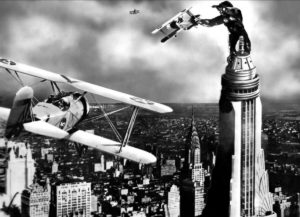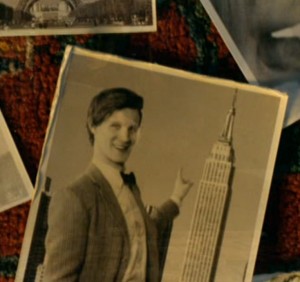Welcome to The History Geek. This is a new generally regular column I’ll be tackling here at Big Shiny Robot! I think a lot of us that are geeks are fascinated by history, too. I’ll be trying to tackle the most interesting bits I find and bringing them to you.
I hope you enjoy and come back for more!

The Empire State Building has had a place in popular culture since its inception. It was a point of pride to have the tallest building in the world, an engineering feat worthy of awe. Soon it forever became a piece of geek culture, with the climax of King Kong (1933) playing out on the Art Deco spire of the Empire State Building that was originally designed for docking zeppelins. It’s featured prominently in everything from Doctor Who to An Affair to Remember, but none of the movies featured a zeppelin.
Through the late 1920s and early 1930s, travel by Zeppelin was becoming more and more popular. The Graf Zeppelin and the ill-fated Hindenburg made regular trips across the Atlantic with passengers and mail. It could travel between 70 and 80 miles per hour, making it by far the fastest way across the Atlantic at the time. During the 1936 season, the Hindenburg flew almost 200,000 miles in the air, carried almost 3,000 passengers, and transported 160 tons of freight and mail back and forth from Europe. The Graf Zeppelin, from the same company, was the first airship to ever clock more than 2,000,000 miles travelled in the air.
Zeppelins seemed, by all accounts, to be the future of mass, long distance travel. To get across the Atlantic, some blimps could make it in only a day or two. The average steam freighter took at least 5 or 6 days.
Since the best place near New York City to drop passengers off by Zeppelin was in Lakehurst, New Jersey, the owners of the soon-to-be-erected Empire State Building decided they could steal away that business and foot traffic.
Alfred E. Smith, the man in charge of the collective of investors building the new high-rise, announced in 1929 that the building would be 200-feet higher than the original plans and it would serve as a mooring mast for zeppelins so people wouldn’t have to come into the city from New Jersey when arriving by dirigible.
The now-iconic Art Deco spire would serve as a welcome to trans-Atlantic passengers.
From a piece in the New York Times:
Mr. Smith said that at the Empire State Building, airships like the Graf, almost 800 feet long, would “swing in the breeze and the passengers go down a gangplank”; seven minutes later they would be on the street…
…The original docking level is one floor above the 102nd-floor observatory, up some steep stairs behind an unmarked door. The stairs lead to a circular room perhaps 25 feet across. A door leads out to the circular terrace where passengers fresh from Europe or South America — and their steamer trunks — were to have set foot on American ground.
The terrace is perhaps two and a half feet wide, and the parapet could not be any higher than that; it’s like standing on the raised lip of a Campbell’s soup can, a quarter-mile up.
It was a great dream, but the Germans (who were the leaders in zeppelin technology and travel) dismissed the idea as impractical. To moor a zeppelin required lots and lots of ground crew and ropes and lines at the front and back of the ship. Mooring to the Empire State Building at just one end would be shaky at best.
The docking port remained at the top of the building while designers and engineers waited for technology that would make the mooring practical. The building opened to much fanfare in 1931 as the tallest in the world, but no zeppelin had yet attempted to dock.
In December of 1931, the US Navy flew an airship to the Empire State Building at the request of a company looking to obtain newsreel footage of the event. The Navy found the winds, clocking in well over 30 miles per hour, treacherous.
Later, the Goodyear blimp Columbia delivered a stack of newspapers to the top of the building, but they were only able to accomplish the feat by lowering the bundle of papers by rope more than 100 feet. The Columbia tried again the next day to dock with the building but failed in its attempt, which was the last time a zeppelin attempted such a feat.
Soon, a broadcast antenna was put on the top of the building and dreams of a dirigible docking station were left behind. It wasn’t three years later until the dream of zeppelins entirely were left behind as a popular means of transportation, with the tragedy of the Hindenburg in New Jersey.
The entire tragedy of the Hindenburg was caught dramatically on film:
After that, no one felt safe. 35 people on board died in the explosion and so did one member of the ground crew. This marked the end of the airship era.
The photograph that accompanies this piece is actually a composite. The dirigible Los Angeles passed by the Empire State Building in 1931, but it happened after dark and no photograph could be taken.
If you want to keep up with Bryan, follow him on twitter or visit his writing website.
